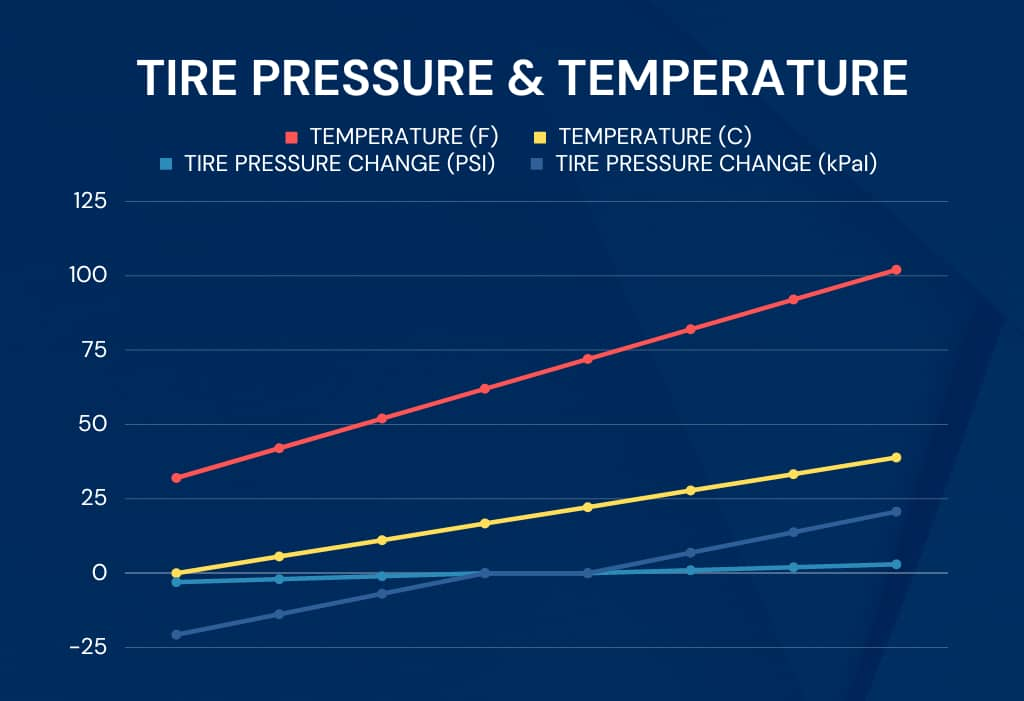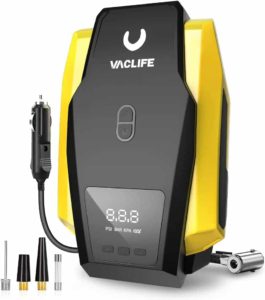Steps to Reset the Hyundai Ioniq Tire Pressure Light
The Hyundai Ioniq does not have a tire pressure reset button.
Fill your tire to the exact recommended pressures. We provided a chart below to match your tire size and battery version to the recommended pressure for the front and rear tires.
Drive your Ioniq. Drive for a few minutes at speeds over 20 Mph.
If the light doesn’t go off right away, re-check your tire pressure to make sure they are all at the exact pressure you set them to. If they are not at the same pressure, you probably have some sort of tire leak.
If the pressures are at the exact pressure you set them to and the light still won’t go off, over fill your tires.
We recommend filling your problem tire with 45 Psi. With the tire overfilled, drive the car again. This will turn off the tire light.
Now that the tire light is off, readjust the pressure back to the recommended pressure.
Match your tire size in the chart below with the front and rear tire pressures.
Tire Size | Battery Type | FRONT PSI | REAR PSI |
235/55 R19 | 2WD | 36 | 36 |
235/55 R19 | 2WD EXT | 38 | 38 |
235/55 R19 | AWD | 36 | 36 |
255/45 R20 | AWD EXT | 34 | 34 |
SPARE TIRE | 60 | 60 |
How to Change Pressure Units
To change the tire pressure measuring units go to the Settings menu in the infotainment system screen and select:
Setup
General settings
Unit
Tire air pressure unit
Psi/kPa/bar
Hyundai Ioniq TPMS Malfunction Indicator
Your car has a special warning light that tells you when there’s a problem with the tire pressure monitoring system (TPMS). The malfunction indicator uses the same yellow exclamation point as the tire warning light. If there’s an issue with the TPMS, the light will blink for about a minute and then stay on. This will happen every time you start your car until the problem is fixed. When this warning light is on, the system might not be able to tell you if your tires have low pressure, like it’s supposed to. Basically, this means if your tire pressure light is blinking, it’s indicative of a problem with the TPMS itself rather than an actual air pressure issue. Usually a faulty pressure sensor in one of your tires. To figure out which tire sensor is causing the problem, you’ll need a TPMS diagnostic tool, like the Autel TPMS tool.
Always Reset the Ioniq TPMS in These Cases:
After inflating or deflating tires to the recommended pressure
After a tire rotation or tire replacement.
When a TPMS sensor is replaced or serviced
After installing a new wheel or tire size
If the TPMS malfunction indicator is triggered
Seasonal changes that may affect tire pressure due to temperature fluctuations
How Does the Hyundai Ioniq TPMS Work?
The tire pressure monitoring system (TPMS) in the Hyundai Ioniq is a safety feature designed to help drivers maintain proper tire pressure. Here’s a breakdown of how the TPMS works in your Hyundai Ioniq:
Individual tire pressure sensors: Each tire is equipped with a pressure sensor that is mounted on the end of each tire valve stem. These sensors are battery-powered and measure the air pressure and temperature within the tire.
Wireless data transmission: The tire pressure sensors transmit data wirelessly to the TPMS control module or the vehicle’s main electronic control unit (ECU). The transmission frequency is typically in the 315 MHz or 433 MHz range. The system continuously monitors the received data for any significant changes in tire pressure.
Data processing and analysis: The TPMS control module and ECU processes the tire pressure data and compares it to the Hyundai Ioniq’s recommended tire pressure levels. If the pressure in any tire deviates from the recommended range, the TPMS triggers a warning. (Usually around 10-15% deviation in pressure will trigger the light)
Dashboard warning light: When the TPMS detects low tire pressure, it activates a warning light on the dashboard, in the shape of a yellow exclamation mark. This alerts you that at least one tire has low pressure and requires attention.
Malfunction indicator and diagnostic information: If the TPMS encounters a fault or a sensor fails, the warning light will flash for approximately one minute before staying lit continuously. (this is the malfunction indicator explained above) The TPMS control module or ECU can store diagnostic information (trouble codes) related to any detected faults, which can be accessed and analyzed using this Autel TPMS diagnostic tool.
Sensor battery monitoring: The batteries in the tire pressure sensors have a limited life span, usually around 7-10 years. The TPMS is designed to monitor the battery life of the sensors and will trigger a warning (Again, the malfunction we explained above) if a sensor’s battery is nearing the end of its life, indicating that the sensor needs to be replaced. The Hyundai Ioniq sensor batteries are not replaceable. When a sensor dies, it must be replaced.
9 Causes Your Tire Pressure Light Will Turn On
The Hyundai Ioniq TPMS light can turn on for various reasons, indicating potential issues with the tire pressure or the TPMS system itself. Here is a list of potential causes for the TPMS light to turn on:
Low tire pressure: If one or more tires have pressure below the recommended level, the TPMS light will illuminate to alert the driver.
Rapid pressure loss: A sudden drop in tire pressure, such as from a puncture or blowout, will cause the TPMS light to come on.
Sensor malfunction: If one or more of the tire pressure sensors is not functioning correctly, it can cause the TPMS to malfunction.
Dead sensor battery: The tire pressure sensors have non-replaceable batteries, which typically last between 7-10 years.
Damaged sensor: Physical damage to a tire pressure sensor, such as from an impact or corrosion, can cause the TPMS light to illuminate.
TPMS control module malfunction: If the TPMS receiver module is not functioning correctly, it can trigger the TPMS light.
Communication issues: Problems with the communication between the tire pressure sensors and the TPMS receiver module can cause the TPMS light to turn on.
Missing sensor: If you replace a wheel or rim and don’t swap over the tire pressure sensor from the old wheel to the new, the tire light will stay on.
Seasonal temperature changes: Significant fluctuations in temperature can cause the tire pressure to change, which may trigger the TPMS light.
If the TPMS light turns on, it is essential to identify and address the issue to maintain optimal tire pressure in your Hyundai Ioniq.
How Does the Weather Affect Your Tire Pressure?

This graph shows how temperature impacts tire pressure in Fahrenheit, Celsius, PSI, and kPa. When it’s colder, tire pressure decreases; when it’s warmer, tire pressure increases. Around 62°F (16.7°C), tire pressure is stable. For every 10-degree temperature drop, tire pressure falls by 1 PSI.
Benefits of the Hyundai Ioniq TPMS
Here are just a few of the marvelous benefits this ingenious system offers:
Improved safety: TPMS helps prevent accidents caused by underinflated or overinflated tires.
Better fuel efficiency: Properly inflated tires reduce rolling resistance, leading to improved gas mileage.
Longer tire life: Maintaining optimal tire pressure prolongs the life of the tires by ensuring even tread wear.
Enhanced vehicle performance: The TPMS ensures that tires maintain proper contact with the road, improving handling and braking.
Real-time monitoring: The TPMS continuously monitors tire pressure, providing instant alerts if an issue arises.
Peace of mind: TPMS takes the guesswork out of maintaining tire pressure, providing assurance that your tires are in good condition.
Reduced environmental impact: Proper tire inflation helps reduce CO2 emissions and supports overall eco-friendly driving.
Cost savings: By improving fuel efficiency and extending tire life, TPMS can save drivers money over time.
Conclusion
In conclusion, the Hyundai Ioniq TPMS is a vital safety feature designed to optimize tire pressure, enhance vehicle performance, and ensure driver safety. By understanding how the system works and addressing any issues promptly, you can enjoy a safer, more efficient, and eco-friendly driving experience.
Please note that this blog post contains Amazon affiliate links. This means that if you make a purchase through one of these links, we at TPMSRESET.com may earn a small commission at no extra cost to you. We only recommend products that we personally use and believe in. Thank you for supporting us.




